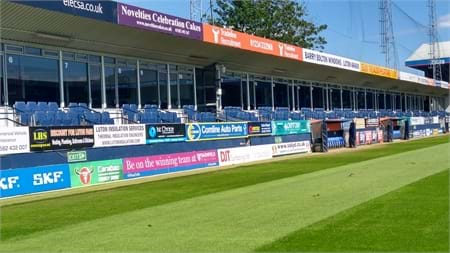Pirtek Luton first sponsored Luton Town FC in the 2017 – 18 season and now “The Hatter” have been promoted to league one, Pirtek Luton is going with them. Not only that, but it hopes to have increased commitment for the coming season. “Luton has now been promoted and we’re obviously delighted,” says David Hoskins comercial manager at Luton’s Kenilworth Stadium. “League one is a completely different prospect from League Two. We’ve got a good squad and we are adding to it. There will be some annoucements soon.”
Elements
Any football club is made up of three elements, David explains. “It is a sporting institution, dedicated to winning games, silverware and achieving promotion through the leagues. It is a business, which keeps the team afloat and provides the money for investment in players, infrastructure and other resources. And it is part of the community, supported by its fans in a reciprocal relationship.
“Without any of these elements, the club cannot succeed.”
Fan base
David is particularly proud of the fans at Kenilworth Road, who have supported the club through good times and bad, turning out in droves to games in the lower leagues at which the opposition could only muster a handful.
“What has been consistent at this football club is, they are loyal out there – the fans come in their droves. There was one season we finished – I think – seventh in the Conference, which is the lowest point. We still had 6,000 people out there. Unbelievable!”
Community
Luton is a club with a history of participation in the local community. The football club has an academy that draws up local players, including in the very early stages of his career, Arsenal (now West Ham) and England midfielder Jack Wilshere, whose signed shirt is hung on the wall of the Morecambe bar. This function room is dedicated to the comedian of the seventies and eighties, whose sons live locally.
The Hatters are also highly engaged with the diverse local community.
“We won Football League Two family club of the year this year,” David says. “We looked to what we were doing around the ground, what the offerings were. We did a couple of quick wins on that, but we also concentrated on trying to up our game a little bit.
“It’s got water in it rather than coke; it’s got an apple in it rather than a bag of crisps. This is something other clubs aren’t doing.”
“We were the first professional football club to pay the national living wage,” says David proudly. “As a club, every member of staff pays a donation to Luton food bank every month.
“We support three charities per year – a club charity, a supporters’ charity and a players’ charity. We get about 30 applications a year – it’s difficult to choose one because they’re all worthwhile but by concentrating on three charities it means you can not only raise a lot of money but also raise their profile.”
David gives an example of how this works. “There is a lot of poverty in Luton,” he says. “We had a club charity a couple of years ago called the Level Trust, a new-ish Luton charity enabling thousands of kids in the town to have a coat and a pair of shoes when they go to school.”
It is proven that well-nourished kids learn more.
“What a fantastic charity,” David says. “It was local, it was for kids, but as Jane who runs the charity said, ‘You didn’t just give us money, the profile you gave us was enormous.’”
Speaking to the club’s engagement with the local community, David says, “It’s about health, it’s about life skills. If we find the next superstar player locally, that’s great. But that’s not what it’s about. It’s about engaging in your local community.
“Yes, we want to be successful on the football front. Yes, we want to be successful on the business front – and we will be on both by the way. But it’s just as important to us to make sure we are engaged with the community.”
A new stadium
Stadium design is critical to providing atmosphere at games and David feels that Kenilworth Road has a special feeling to it. While this may have been achieved by accident in the early days of the Football League more than one hundred years ago, these days stadiums can be designed with acoustics and other technical elements in mind.
Now on an upward trajectory, Luton Town FC hopes to receive planning permission for a new 20,000-seater, Premier League-standard stadium, not far from the original Kenilworth Stadium, very soon.
Reflecting David’s tripartite view of a football club, this multi-million-pound development will be supported by an enabling scheme at junction 10 of the M1, which includes a music venue, restaurants and bars, hundreds of apartments and retail facilities.
This is the kind of scheme Pirtek excels at working on. The company is also contracted to service heavy duty machinery on a number of high-profile infrastructure projects in London, detailed elsewhere in this issue.
Regarding the new stadium, David says, “It’s not just about having more people at games. It’s about what we do for the rest of the year when we’re not playing – weddings, conferences, classes. There’s a massive income to be had that we don’t get here at Kenilworth Road.
“It’s going to have a hotel with it and all the conferencing and banqueting facilities will be on a different scale.”
In the meantime
With a decision on planning permission due in August, completion of the stadium is a number of years away.
“We’re looking for a good season,” David says. “We’ve tried to be sensible on pricing, and it’s worked. Season ticket holdership has gone up for next season. We have three kits and three sponsors now, which is working well.
“And our academy is thriving, as it always is. It is full of local players, there are some from further afield and we have sponsorship deals with national companies that help us accommodate them.
“Luton Town has an England under-21, we’ve got an Ireland under 21, we’ve got a Malta full international, Luke Gambin, and there are several others who represent their countries at younger levels.”
And while the fans enjoy their last few seasons in their traditional home, hopefully continuing their rise up the ranks, Pirtek Luton’s name will be a prominent feature. Currently their advertising hoarding is close to the dugout but a new, larger and more prominent banner will soon be seen above left of the goalmouth.
The Luton family
“I’ve been with Luton Town for 10 years,” says David. “When I first came to Luton in 2008, it was the day after we’d come out of administration.
“When 2020 took this club over, it was going out of business. We looked to rebuild from scratch.
“Previously we’d had a number of large companies as sponsors. We said let’s start again. Let’s get 100, 150 small companies. If they’re paying a reasonable sum each year, that all adds up.
“That was our first year and we won the Johnstone’s Paint Trophy.” The two-thirds sized replica sits in the trophy cabinet alongside various other silverware.
Pirtek, too, is all about the career path, with many of the franchisees working their way up from the the shop floor.
Keith West bought Pirtek Luton just as the recession kicked in. He explains, “I signed the cheque one day, the next I thought, ‘What are you doing?’”
He weathered the storm, however. “I’ve got good experience, I’ve kept it afloat through good and bad times.”
The club has another connection with Pirtek Luton. Justin James, a right back for The Hatters is the nephew of a Pirtek Luton office worker. “Good player, very good player,” says David. “He’s going to play to a very high standard.”
With a mutual self-interest in the club’s success, Pirtek Luton shares David’s hopes.






Select a country